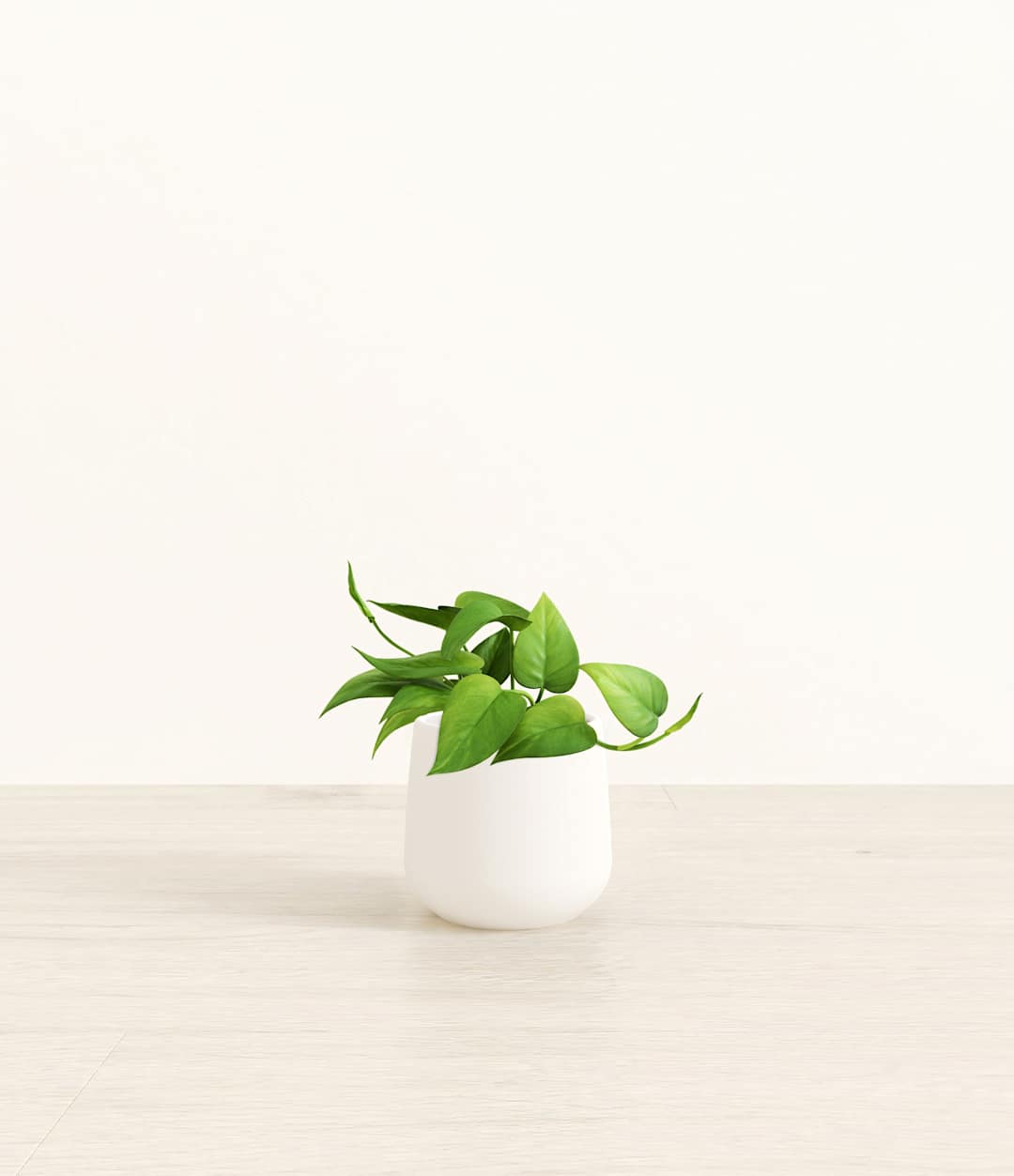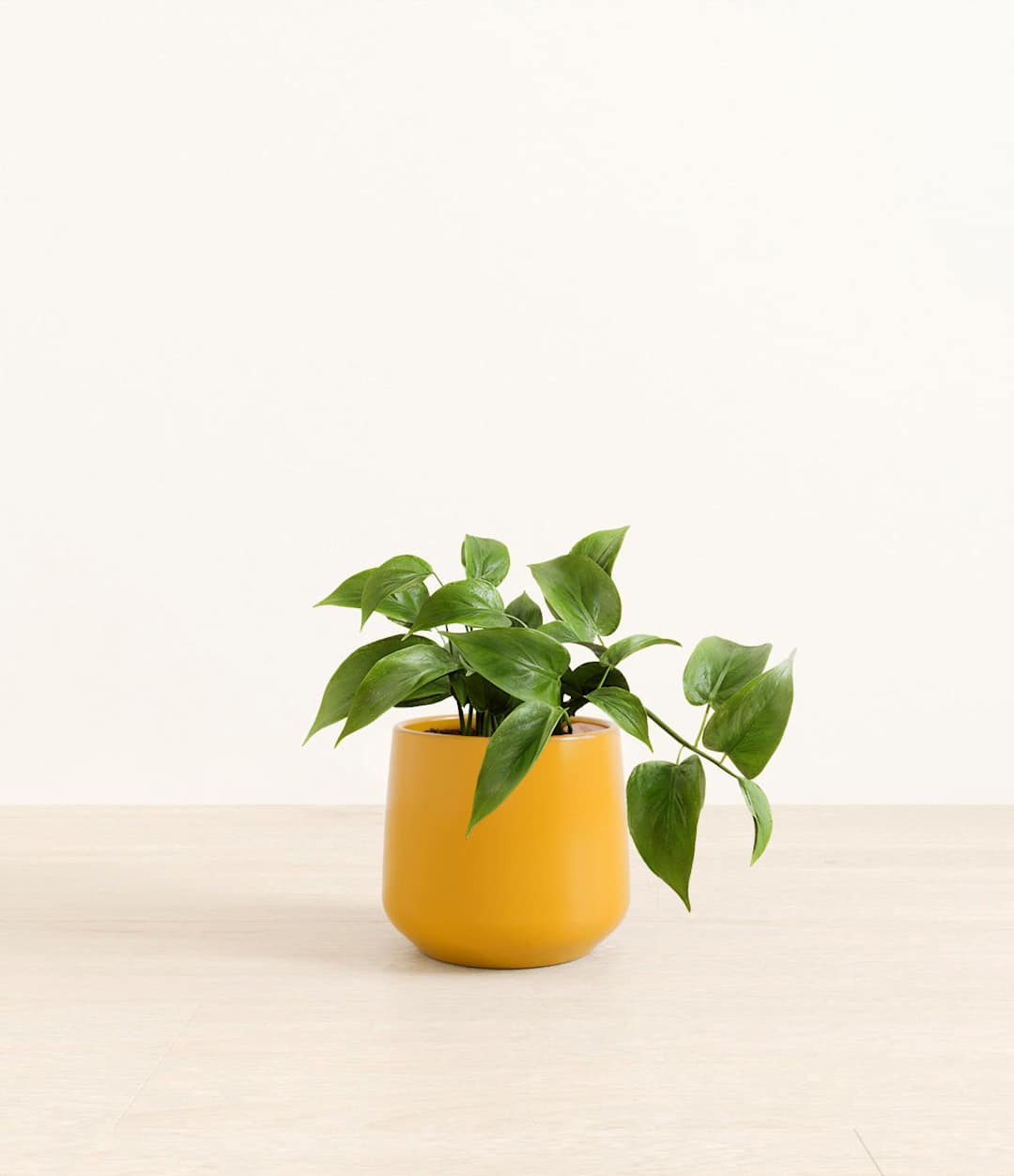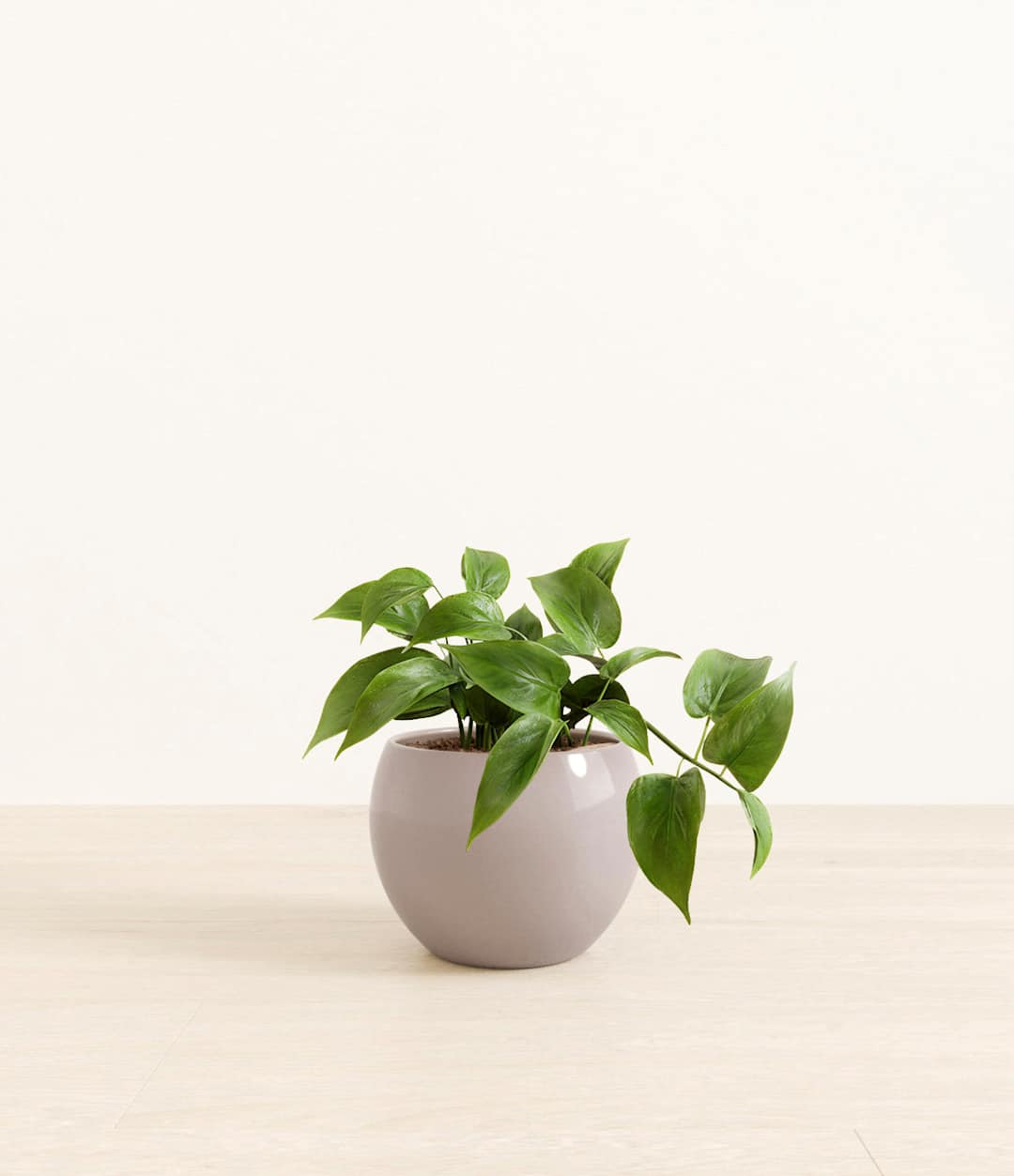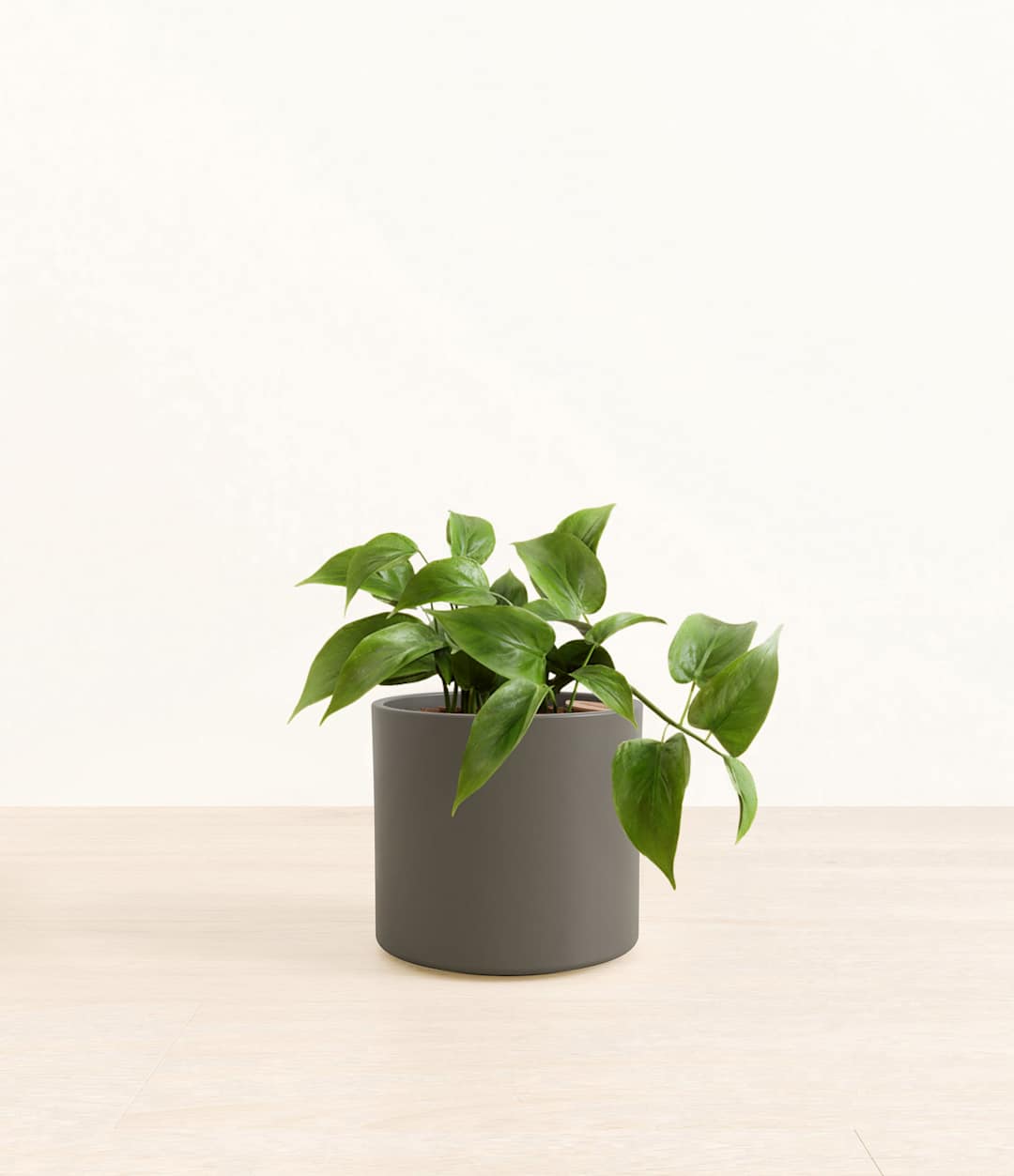Plant care library / Jade Pothos
How to Care for Jade Pothos
Shop this plantAbout Jade Pothos
Our love for this natural trailer is as ancient as love itself, earning it the name Pothos - the god of love named after the Greek word for 'yearning' and symbolized carrying a vine stretching as far and wide as the heart's desire. Hailing from the Pacific Islands, Jade Pothos is known for its admirable resilience and graceful vines and wears a classic deep green foliage bringing about a perfect sense of calm.
Other common names
- Centipede Vine
- Hunter's Rove
- Epipremnum Aureum
- Golden Pothos
- Jade Pothos
How Often Should I Water My Jade Pothos?
The Jade Pothos is drought-tolerant and isn't high maintenance regarding watering frequency. The primary cause of the plant's decline is overwatering. Luckily, with easyplant, watering your Jade Pothos plant is simple. Check the easyplant reservoir once a month, fill it when empty, and you're all set!
If you don't have an easyplant pot to make your watering hassle-free, manually water your Jade Pothos when the two inches of the soil are dry. Check the soil, especially if your plant is in low light conditions, as they may take longer to dry out. Once you've thoroughly watered your plant, dump any excess water left in the saucer. An indicator that your plant needs water if the leaves begin to droop. Once you've watered it, you should see your Jade Pothos perk up. Distilled or rainwater is preferred for watering, but if you use tap water, leave it out overnight so harmful chemicals can dissipate.
Jade Pothos Light Needs
Jade Pothos grows best in a well lit space with medium to bright light and can adapt to low light or spaces without natural light as well.
The best places to place your Jade Pothos are spaces where bright light streams in but isn't direct, like a bookshelf near a window. Since they're native to the forest floor, they are used to a certain degree of leaf coverage, which makes them susceptible to leaf scorch if left in harsh direct sunlight.
Jade Pothos Plant Care
During your Jade Pothos' first few days at home, one or two leaves might fall or turn yellow; this is a normal part of adjustment and is no cause for concern. Once adjusted, Jade Pothos is very easy to care for and will reward your love for it by quickly bouncing back from any mishap. To help it grow optimally and evenly, occasionally dust the leaves and rotate the pot by a ¼ turn once a month.
How Big Do Jade Pothos Plants Grow?
Jade Pothos is a natural trailer that will grow long and can eventually be hung across a wall or trail down a high shelf. The plant should grow new leaves frequently under the right circumstances. These leaves will grow up to 8 inches in length.
The Jade Pothos is a relatively fast grower. This plant typically grows between 30 feet in optimal conditions. However, these plants look best when kept between 6-10 feet. Jade Pothos can tolerate being slightly root bound but will need repotting every one to two years.
This plant adds an average of 18 inches every month. With this growth rate, it takes Jade Pothos less than two years to reach full maturity. Many factors contribute to the growth of this plant, including proper lighting, regular watering, adequate temperatures, and humidity levels.
Temperature & Humidity
Pothos is a tropical plant that thrives in warm climates. The ideal temperature for the Jade Pothos is between 65-85˚F (18-29˚C). If temperatures in the space drop below 50˚F (10˚C), it could begin to affect the health of your Pothos. These plants are sensitive to cold and should not be placed near drafts, A/C, heating vents, or fans.
Even though the Jade Pothos is a tropical plant, it can acclimate to the typical humidity levels in homes. These plants still love high humidity, so you can always raise the humidity levels by using a humidifier, placing the plant near a pebble tray with water, in a room with high humidity levels or next to other plants.
Are Jade Pothos Toxic for Pets & Kids?
Some plants add a pleasing aesthetic to the home and can adapt well to the indoor environment but are unsafe to keep in the house. When considering a houseplant, it's important to know if anything toxic about the plant could harm children or animals if touched or ingested.
Jade Pothos may be moderately toxic if ingested, so be sure to keep away from curious children and pets. All parts of the plant contain calcium oxalate crystals, which, if ingested, can cause irritation and swelling of the tongue, mouth, and throat. The plant's sap can also be an eye irritant and cause contact dermatitis when touched.
This plant is no more toxic to dogs than cats and vice versa. If your pet ingests any portion of the plant, contact your vet or take your pet to an emergency pet hospital. If children ingest any portion of the plant, contact a physician and monitor their symptoms.
Troubleshooting Common Problems with Jade Pothos
Part of plant care is observing how your plant is fairing in its environment, so you can make adjustments if needed. Every houseplant will have different signs or tells when they aren't doing well. Here are a few things to look out for with the Jade Pothos and what to do to fix the issue;.
If multiple leaves turn pale or yellow, relocate the pot to a less brightly lit area. The yellowing of the leaves could also be due to overwatering, so pull back on the frequency, check the soil before watering, and don't let your plant sit in excess water.
If you notice the tips of Jade Pothos leaves starting to brown around the edges, this indicates under watering. Be sure not to let the soil dry out completely, but only the top two inches before watering. Lack of humidity could also be the issue, so add a humidifier, place it near a pebble tray or group it with other plants
Pothos plants, in general, can be susceptible to a host of pests. These plants primarily struggle with spider mites and mealybugs but can also be a host to whiteflies, thrips, plant scale, and aphids. A couple of signs indicate a pest problem: brown, yellow, or black spots in groupings with leaf deformation or milky webbing on the underside of the leaf. Remove the pests with a thorough rinsing or cloth and alcohol, then treat your Jade Pothos with insecticidal soap or neem oil.
Frequently Asked Questions about Jade Pothos Plant
- Is Jade Pothos an Indoor Plant?Jade Pothos is both an indoor and outdoor plant. In its native environment, it grows in the understory forest in the Solomon Islands. However, it is highly adaptable to various growing conditions and can thrive indoors.
- Where Do You Put Jade Pothos?Since Jade Pothos is so adaptable to different environments, you can place the plant almost anywhere. Since it is a vining plant, consider placing it high to allow the vines to hang down or accommodate the vines spreading across walls. The more indirect light the plant has, the happier it will be and the faster it will grow.
- Are Jade Pothos Plants Easy to Care For?Jade Pothos are extremely easy to care for and are great plants for beginners. They can adapt to various light exposures, humidity levels, and watering schedules. If you want your plant to thrive, it's important to learn proper care and monitor it for common issues.






